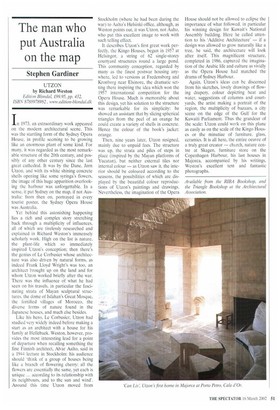The man who put Australia on the map
Stephen Gardiner
UTZON by Richard Weston Edition Blondal, £99.95, pp. 432, ISBN 8788978982, www.edition-blondaLdk In 1973. an extraordinary work appeared on the modern architectural scene. This was the startling form of the Sydney Opera House, in profile seeming to be growing like an enormous plant of some kind. For many, it was regarded as the most remarkable structure of the 20th century, and possibly of any other century since the last great cathedral. It was by the Dane, Jorn Utzon, and with its white shining concrete shells opening like some syringa's flowers, the image of this huge apparition overlooking the harbour was unforgettable. In a sense, it put Sydney on the map, if not Australia: from then on, portrayed in every tourist poster, the Sydney Opera House was Australia.
Yet behind this astonishing happening lies a rich and complex story stretching back through a multiplicity of influences, all of which are tirelessly researched and explained in Richard Weston's immensely scholarly work. High on the list is nature, the plant-life which so immediately inspired Utzon's conception; then there's the genius of Le Corbusier whose architecture was also driven by natural forms, as indeed Frank Lloyd Wright's was too, an architect brought up on the land and for whom Utzon worked briefly after the war. There was the influence of what he had seen on his travels, in particular the fascinating strata of Mayan sculptural structures, the dome of Isfahan's Great Mosque, the fortified villages of Morocco, the diverse forms of nature found in the Japanese houses, and much else besides.
Like his hero, Le Corbusier, Utzon had studied very widely indeed before making a start as an architect with a house for his family at Hellebaek. Weston, however, provides the most interesting lead for a point of departure when recalling something the fine Finnish architect, Alvar Aalto, said in a 1944 lecture in Stockholm: his audience should 'think of a group of houses being like a branch of flowering cherry: all the flowers are essentially the same, yet each is unique ... according to its relationship with its neighbours, and to the sun and wind'. Around this time Utzon moved from Stockholm (where he had been during the war) to Aalto's Helsinki office, although, as Weston points out, it was Utzon, not Aalto, who put this excellent image to work with such telling effect.
It describes Utzon's first great work perfectly, the Kingo Houses, begun in 1957 at Helsingor, a string of 62 single-storey courtyard structures round a large pond. This community conception, regarded by many as the finest postwar housing anywhere, led to versions at Fredensborg and Kronborg near Elsinore, the dramatic setting there inspiring the idea which won the 1957 international competition for the Opera House. Much is memorable about this design, yet his solution to the structure was remarkable for its simplicity: he showed an assistant that by slicing spherical triangles from the peel of an orange he could create a variety of shells in concrete. Hence the colour of the book's jacket: orange.
Then, nine years later, Utzon resigned, mainly due to unpaid fees. The structure was up, the strata and piles of steps in place (inspired by the Mayan platforms of Yucatan), but neither external tiles nor internal colour — as Utzon saw it, the interior should be coloured according to the seasons, the possibilities of which are displayed by the beautiful colour reproductions of Utzon's paintings and drawings. Nevertheless, the imagination of the Opera House should not be allowed to eclipse the importance of what followed, in particular his winning design for Kuwait's National Assembly building. Here he called attention to his 'Additive Architecture' — if a design was allowed to grow naturally like a tree, he said, the architecture will look after itself. This magnificent structure, completed in 1986, captured the imagination of the Arabic life and culture as vividly as the Opera House had matched the drama of Sydney Harbour.
Again, Utzon's ideas can be discerned from his sketches, lovely drawings of flowing drapery, colour depicting heat and water, suggestions of columns and courtyards, the artist making a portrait of the region, the multiplicity of bazaars, a city scene on the edge of the Gulf for the Kuwaiti Parliament. Thus the grandeur of the scale: Utzon could work on this plane as easily as on the scale of the Kingo Houses or the minutiae of furniture, glass, ceramics. It is all here, the entire oeuvre of a truly great creator — church, nature centre at Skagen, furniture store on the Copenhagen Harbour, his last houses in Majorca, accompanied by his writings, Weston's excellent text and fantastic photographs.
Available from the RIBA Bookshop, and the Triangle Bookshop at the Architectural Association.
















































































 Previous page
Previous page